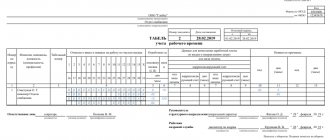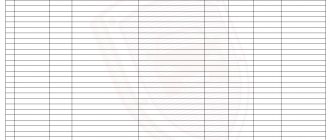Who is required to undergo medical examinations?
Undertaking preventive medical examinations can be either an obligation of employees of enterprises and organizations, or a voluntary event.
Typically, mandatory examinations must be carried out:
- employees of medical and educational institutions;
- those who work with food (regardless of whether in production, trade or catering);
- employees of organizations involved in the maintenance of water supply networks and communications.
There are other categories of hired personnel for whom passing medical examinations is the main condition for admission to work - all of them are specified in the legislation of the Russian Federation.
In some cases, enterprise management insists on a medical examination of employees, even if this obligation in relation to this group of specialists is not prescribed by law. This practice is especially common in large companies where medical care for staff is provided under voluntary health insurance policies.
What documents must the employee submit to the medical commission?
According to the new rules, an obligation was introduced for the employee to submit to the medical commission SNILS or a document that confirms registration in the individual (personalized) accounting system, in electronic or paper form.
In addition, the employee has the right to submit to the medical commission an extract from the medical record with the results of the medical examination. If the employee underwent medical examination less than a year ago, the medical organization can take these results into account during the medical examination.
At the same time, the employee no longer needs to submit a health passport to the medical commission. If previously the medical commission issued a health passport to the employee, and then the employee presented it to the commission at each medical examination, now the health passport has lost its meaning.
This is what the final list of documents looks like that an employee must submit to the medical commission in order to undergo a medical examination:
- direction;
- SNILS or a document that confirms registration in the individual (personalized) accounting system, in electronic or paper form;
- passport;
- the decision of the medical commission, which conducted a mandatory psychiatric examination, for individual employees.
How often to get medical checkups
The frequency of medical examinations may vary. Surveys can be divided into several main types:
- preliminary (when a medical examination is necessary for a person to be allowed to perform his work duties);
- periodic (when medical examinations are carried out with a certain regularity to confirm the health of workers);
- unscheduled;
- all the remaining ones.
It should be noted that if the company has a system of periodic medical examinations, then a schedule must be developed and all employees must follow it.
The frequency of medical examination by the organization’s personnel is determined by the field of activity and the specifics of the organization.
Who should undergo periodic inspection?
Order 302n of the Ministry of Health clearly stipulates the list of works, during the performance of which and in the presence of any hazardous factors at work, mandatory medical examinations are required for workers.
The following employees must undergo periodic medical examinations:
- Workers exposed to harmful or dangerous production factors, in the presence of which mandatory preliminary and periodic medical examinations are carried out;
- Workers performing work specified in the list of works, during which mandatory preliminary and periodic medical examinations of workers are carried out;
- Traffic related.
Let us list the mentioned factors and activities.
- workers in the chemical, oil and gas, medical industries;
- involved in underground, underwater and high-rise work, in construction. Such employees undergo periodic medical examinations annually (clause 12 of Appendix 2 to Order No. 302n);
- employed in organizations of the food industry, public catering and trade, in the provision of consumer services, water supply facilities, medical organizations and child care institutions and in the field of education (Article 213 of the Labor Code of the Russian Federation).
Pay attention to the Resolution of the Supreme Court of the Russian Federation dated December 6, 2017 No. 34-AD17-5. It follows from it that workers in the trade sector are required to undergo periodic medical examinations (order 302n), even if they are engaged in administrative work not directly related to trade relations. The requirements of the order of the Ministry of Health apply to companies that sell non-food products.
The frequency of medical examinations for specific professions is given in Appendix No. 2 to Order No. 302n.
- Athletes. They undergo medical examinations annually (Article 348.3 of the Labor Code of the Russian Federation).
- Persons under 21 years of age. They undergo medical examinations annually (Article 266 of the Labor Code of the Russian Federation).
The list of works lists jobs and professions in which workers must undergo mandatory preliminary and periodic medical examinations, regardless of the established class of working conditions in these workplaces and the presence of harmful and hazardous production factors (see table).
Table 1 – List of jobs and professions for which workers must undergo mandatory preliminary and periodic medical examinations.
| Name of work and professions | Inspection frequency* |
| 1. Work at height, as well as work on maintenance of lifting structures, including: | 1 time per year |
| 1.1. Work as a crane operator (crane driver) | 1 time every 2 years |
| 1.2. Elevator job | 1 time every 2 years |
| 2. Maintenance and repair work on existing electrical installations with voltages of 42 V and above AC, 110 V and above DC, as well as installation, adjustment work, testing and measurements in these electrical installations | 1 time every 2 years |
| 3. Work on felling, rafting, transportation, primary processing, protection and restoration of forests | 1 time every 2 years |
| 4. Work in special geographic regions with a significant distance between the work sites and medical institutions providing specialized medical care | 1 time per year |
| 5. Work directly related to the maintenance of pressure vessels | 1 time every 2 years |
| 6. Work directly related to the use of flammable and explosive materials, work in explosion and fire hazardous industries | 1 time per year |
| 7. Work in paramilitary security, special communications services, cash collection apparatus, banking structures, and other departments and services that are allowed to carry weapons and use them | 1 time per year |
| 8. Work performed by the gas rescue service, voluntary gas rescue squads, paramilitary units and detachments for the prevention and elimination of open gas and oil gushers, paramilitary mining and mountain rescue services of ministries and departments, fire protection | 1 time per year |
| 9. Work performed by emergency rescue services to prevent and eliminate emergencies of a natural and man-made nature | 1 time per year |
| 10. Work performed directly on mechanical equipment that has open moving (rotating) structural elements (lathes, milling and other machines, stamping presses, etc.) | 1 time every 2 years |
| 11. Work under water performed by workers in a gas environment under normal pressure conditions | 1 time every 2 years |
| 12. Underground work | 1 time per year |
| 13. Work performed using insulating personal protective equipment and filtering gas masks with a full face part | 1 time every 2 years |
| 14. Work in food industry organizations, dairy and distribution points, at bases and warehouses of food products, where there is contact with food products during their production, storage, sale, including work on sanitary processing and repair of inventory, equipment, as well as work where there is contact with food products when transporting them on all types of transport | 1 time per year |
| 15. Work in catering organizations, trade, buffets, catering units, including in transport | 1 time per year |
| 16. Work performed by students of educational organizations of general and vocational education before and during internship in organizations whose employees are subject to medical examinations | 1 time per year |
| 17. Work of medical personnel of medical institutions, as well as maternity hospitals (departments), children's hospitals (departments), children's clinics, departments of pathology of newborns, premature babies | 1 time per year |
| 18. Work in educational organizations of all types and types, as well as children's organizations that do not carry out educational activities (sports sections, creative, leisure children's organizations, etc.) | 1 time per year |
| 19. Work in children's and adolescent seasonal health organizations | 1 time per year |
| 20. Work in preschool educational organizations, children's homes, organizations for orphans and children without parental care (persons in their place), boarding educational organizations, recreational educational organizations, including sanatorium type, children's sanatoriums, year-round camps recreation, as well as social shelters and nursing homes | 1 time per year |
| 21. Work in consumer service organizations (bathhouse attendants, shower workers, hairdressers) | 1 time per year |
| 22. Work in swimming pools and spas | 1 time per year |
| 23. Work in hotels, hostels, passenger carriages (conductors), as a flight attendant | 1 time per year |
| 24. Work in medical industry organizations and pharmacy chains related to the production, packaging and sale of medicines | 1 time per year |
| 25. Work on water supply facilities related to water treatment and maintenance of water supply networks | 1 time per year |
| 26. Work related to milk processing and production of dairy products | 1 time per year |
| 27. Control of ground vehicles | 1 time every 2 years |
*If the listed jobs involve persons under 21 years of age, they undergo medical examinations annually (Article 213 of the Labor Code of the Russian Federation).
Attention: Medical examinations should be carried out even if there are harmful or dangerous production factors at the employee’s workplace, specified in the list of facts, regardless of the results of the labor assessment and their level does not matter. Such clarifications are contained in letters of the Ministry of Labor of Russia dated July 16, 2015 No. 15-1/OOG-3786, dated March 21, 2014 No. 15-2/OOG-242.
The following factors are exceptions:
- 3.5 – industrial noise;
- 3.8, 3.9 – air temperature;
- 3.12 – light environment;
- 4.1 – physical overload;
- 4.4.1, 4.4.2, 4.4.3 – sensory loads.
For these factors, medical examinations are carried out when the working conditions they create, based on the results of a special assessment of working conditions, are classified as harmful or dangerous working conditions, about which a corresponding note is made in brackets in the column “Name of harmful and (or) dangerous production factors”.
The employer can send accountants, programmers, management personnel and other office employees who work at a computer more than 50 percent of their working time for a medical examination, but by order of the Ministry of Health No. 187 of April 3, 2021, such employees will need to be not examined only if the maximum limit is exceeded in the workplace. permissible level of the electromagnetic field of the broadband frequency spectrum.
According to the new rules, employees must be sent for a medical examination from May 24, 2021. It will be possible to determine whether the maximum permissible level for employees who work on a computer is exceeded during sanitary production control, since EMF measurements on personal computers during working conditions have not changed and there are no other grounds from paragraph 1 of Article 17 of the Law of December 28, 2013 No. 426 -FZ.
Who draws up the order
As a rule, the direct task of forming an order is assigned to an employee of the secretariat or a specialist from the human resources department, but sometimes this responsibility is performed by a legal adviser or the director of the enterprise himself. In any case, this should be a person who has a clear idea of how to write administrative documents and is familiar with the labor and civil legislation of the Russian Federation first-hand.
How responsibly and attentively the executor will react to drawing up the order depends on future possible claims (or lack thereof) from supervisory authorities (the same labor inspectorate, for example).
After the order is issued, it must be submitted to the head of the company for signature, since without his autograph the document will not gain legal force.
How to competently develop an order based on the results of a medical examination?
Answer published date: 1.
Valid for 1 year Sample notification Position name Full name NOTICE _____________________ (name of organization) notifies you that in accordance with medical report No. ___ dated __.__.20__, issued based on the results of a mandatory periodic medical examination of ________________________ (name of medical organization), you are allowed to work for the period from__ to___ (1 year). After which you will be required to undergo a second medical examination in order to determine your suitability to perform your duties in accordance with the employment contract.
Director ________ Full name Date Reviewed__________ Full name Date 2. Unsuitable for work at height and with hydraulic lifting gear according to Appendix 2, paragraph 1 of Order No. 302 n dated 04/12/2011 If the medical report indicates a prohibition for the employee to continue his previous job, the employer is obliged to offer the employee a transfer to another one that is more suitable for his condition health post.
Features of creating an order to undergo a medical examination at an enterprise
If you are entrusted with the function of forming an order for a medical examination, and you do not know how to approach it, read the recommendations below and look at the sample document.
The order to undergo a medical examination does not have a standard, mandatory form. Company employees have the opportunity to draw it up in any form or, if they have a sample document that is valid in the organization, using its template.
In this case, the document must include some necessary information, such as:
- name of company;
- date, number and place (locality) of drawing up the order;
- rationale and basis for it.
The descriptive part includes:
- date or period of the medical examination;
- the medical organization that conducts it;
- conditions – place, time (hours, minutes) and other parameters;
- positions and full names of employees (this data can also be prepared in a separate list attached to the order);
- sanctions for refusal to undergo a medical examination.
You can supplement the order with any other information, depending on the specific characteristics of the enterprise.
The procedure for conducting medical examinations of enterprise employees
- Compiling a list of employees who must undergo a medical examination. Within 10 days it must be sent by registered mail with notification to the territorial body of Rospotrebnadzor (in the notification procedure, approval is not required).
- Concluding an appropriate agreement with a medical institution, agreeing on a schedule and deadlines.
- Issuing an Order to conduct a medical examination and familiarizing staff with it.
- Issuing referrals for medical examinations.
- Collection of signed and sealed reports with the results of the medical examination. The conclusion is signed in two copies - one of them is given to the employee, the other remains in the institution that conducted the medical examination.
- Within a month, the medical center, together with representatives of the employer and the sanitary and epidemiological service, draws up a final act. After it is approved by the chairman of the medical commission, the act is drawn up in four copies, one of which remains in the medical institution, and the others are sent to the employer, to the territorial body of Rospotrebnadzor and to the center of occupational pathology to replenish statistical data.
- The results of preliminary and periodic medical examinations are recorded in the employee’s personal medical record.
How to draw up a document, what to pay attention to
The design of the order, as well as its text, can be absolutely anything: handwritten or printed. An order can be drawn up either on a regular sheet of any suitable format (but preferably A4), or on company letterhead.
Only one requirement must be met: the order must be certified by an authentic autograph of the director of the company or a person authorized to sign such papers on his behalf.
Also, the order must be signed by employees who are responsible for its implementation and by those who are directly affected by this order. If necessary, representatives of the trade union organization (if there is one, of course) must first be familiarized with the contents of the order against signature.
All orders (and this one is no exception) are drawn up in one original copy and throughout the entire period of validity lie in a special folder along with other valid administrative acts. After losing their relevance, they are transferred for storage to the archive of the enterprise, where they are kept for a period determined by law or the accounting policy of the company.
Where should periodic medical examinations be carried out, and who should pay for them?
The employer must enter into an agreement () with a medical organization licensed to conduct preliminary medical examinations. This requirement applies only to periodic medical examinations; it is not necessary to enter into a preliminary agreement with a medical institution. This requirement is due to the fact that in the process of preparing for periodic medical examination, it is necessary to coordinate lists, a calendar plan, draw up a medical report and a final report for each employee, and transfer it to Rospotrebnadzor. But as practice shows, it is more convenient and profitable for an employer to send its employees to both types of medical examinations at the same medical institution.
A permanent medical commission is formed in a medical organization. It is headed by an occupational pathologist.
The medical organization is responsible for the quality of medical examinations.
A periodic examination is carried out (as well as all medical examinations required by law) at the expense of the employer (paragraph 12, part 2, article 212 of the Labor Code of the Russian Federation), and during its passage, the employee retains his average earnings and place of work (art. 185 of the Labor Code RF).
If an employee has not passed the examination due to the fault of the organization, then the time he is suspended from work is paid as idle time (Article 76 of the Labor Code of the Russian Federation). The amount of payments is not less than 2/3 of the average salary of an employee (Article 157 of the Labor Code of the Russian Federation).
Types and frequency
There are two types of inspection:
- preliminary. It is carried out to obtain permission for a citizen to perform a certain type of work or duties;
- periodic _ To confirm the health status of employees;
- out of plan. If there is a suspicion of an occupational disease.
The frequency of inspection is regulated by local administrative documents.
Hosting an event







